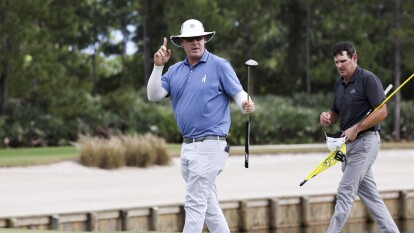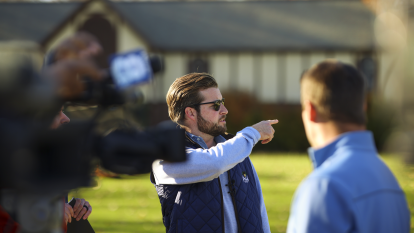This article originally appeared in the May issue of PGA Magazine
Players who competed in the 2007 PGA Championship at Southern Hills Country Club might not readily recognize the course that Tulsa’s own Perry Maxwell designed, when major championship golf returns this month to Southern Hills for the 2021 KitchenAid Senior PGA Championship.
Then again, those who competed in previous PGA Championships and U.S. Opens here might find the classic course looking more familiar than ever.
The field of 156 seniors teeing it up in the KitchenAid Senior PGA Championship will be the first to experience the “new” Southern Hills Country Club, the venerable Tulsa landmark that will be hosting its eighth major championship. Golf course architect extraordinaire Gil Hanse completed an ambitious renovation/ restoration of Southern Hills in 2019, expertly building a bridge between the Golden Age architecture of Maxwell while preparing Southern Hills to remain a major championship venue.
It was a sensitive balancing act for Hanse, who studied the original sketches and photographs of Maxwell’s masterpiece and restored those original characteristics where possible, fusing the needs of a contemporary, 21st-century course that will challenge the finest players and longest hitters in the game.
“My father (the late Jerry Cozby, former PGA Golf Professional of the Year and PGA of America Hall of Fame member) used to be very skeptical when someone would say they were going to restore something, saying there was a fine line between restoring something and ruining something,” notes Southern Hills PGA Director of Golf Cary Cozby. “But when he saw what Gil Hanse accomplished with Southern Hills, he said, ‘this guy gets it.’ My own two cents worth is that when Gil Hanse does restoration work at other courses, just as he has done here at Southern Hills, his signature is not to leave a signature. He just does what the original architect had in mind and updates conditions where necessary.”
Cozby says Hanse’s restoration work has made Southern Hills more aesthetically pleasing, while also probably making it a bit more difficult.
“The bunker styles, the edges around the greens and the green surrounds/chipping areas were totally redone, the greens were all redone with a Pure Distinction bentgrass, underground drainage pipes were all brought to the surface to create a creek system running through the golf course, and some other changes were made to allow the golf course to stretch to about 7,500 yards, if need be,” said Cozby. “The important thing is, the classic character of Southern Hills was preserved while making it challenging for the best players in the world.”
“If you look at the history of the major championships played at Southern Hills, it almost always comes down to who is putting the best that week, which means who can read the subtle slopes and avoid the three-putts,” says Cozby.
Cozby — who will be testing the greens personally as part of the 156-player field in the 2021 KitchenAid Senior PGA Championship — calls the par-4 first hole at Southern Hills one of the toughest starting holes in golf; hole No. 6 the toughest par 3; No. 7 one of the two toughest holes on the course; and the 15th and 18th holes always decisive in major championships.
“Matt Gogel (former PGA Tour winner) came in to play the other day with his caddie, who is a very good player,” recalls Cozby. I asked him which couple of holes caught his eye and he said, ‘Holy cow, that first hole is a tough opening hole.’
“No. 1 is a very challenging opening hole. It’s long (451 yards) and the green complex runs away from you. It’s a good hole to hit it in the center of the green, two putt and walk away with a par. It can create some trouble right off the bat.”
The 200-yard, par-3 sixth hole proved disastrous for several players in the 2007 PGA Championship at Southern Hills. Case in point, Angel Cabrera ruined his championship chances on the sixth hole in the opening round after hitting his first ball into the bushes, re-teed and hit his next shot out of bounds, re-teed and hit his next ball into the water. Cabrera then took a drop, hit it on the green, and proceeded to three-putt his way to a 10.
Hanse moved the green back 40-45 yards on the seventh hole at Southern Hills, which was the only hole Tiger Woods bogeyed during a course-record 63 in the second round of the 2007 PGA Championship en route to victory. “The fairway slopes left to right on the new No. 7, and it’s a left-to-right hole with the creek coming into play more now on the right side all the way up to the green,” notes Cozby. “You absolutely need to hit the green there. Ever since we started keeping hole-by-hole stats, No. 7 has played as one of the two toughest holes on the course.”
Cozby calls the par-4 15th hole “a sleeper hole” in that it appears benign, but always plays as one of the top five most difficult holes in major championships.
The closing hole has been extremely difficult for many players in previous major championships. The dogleg right par-4 measures 426 yards with fairway bunkers looming, and is considered one of the strongest finishing holes in major-championship golf. The second shot is played uphill toward the Southern Hills clubhouse that sits at the highest point of the property. The elevated green is guarded by three bunkers and is one of the most penal on the course. Approaches not struck crisply can feed 40-50 yards back down the slope to the fairway below, or find an uncomfortable home in one of the greenside bunkers.
“A lot of things can happen on the 18th hole, and most of them aren’t good,” says Cozby. “The 18th hole is characteristic of the strategic approach you have to take in playing every hole at Southern Hills. If you fail to put your ball in the proper position on the fairways, you won’t have a good angle into the greens.
“And if you don’t put your approaches in the proper place on the greens, you will have to work extremely hard to two-putt.




